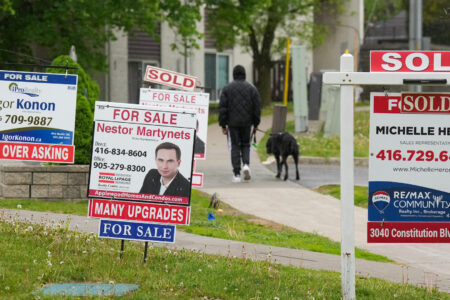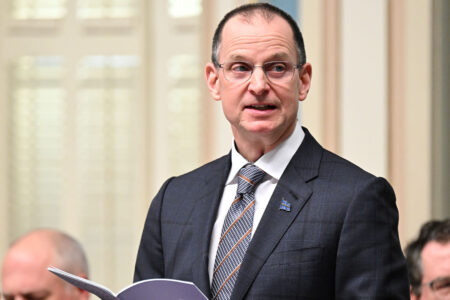
Chatting with a visitor to his Langevin Block office in mid-August, Stephen Harper reflected on the daunting math of a majority, and acknowledged it was an unlikely outcome of an election.
He ran through the scenarios of what he called “four competitive parties in the House,” and concluded that a majority probably wasn’t in the cards, let alone the numbers.
The math of a majority was simple — 155 seats out of 308 in the House of Commons. Getting there was another matter, as the Prime Minister explained. First, he said, the Bloc Québécois would normally win 40 to 45 seats out of 75 in Quebec. Then, the NDP would be good for about 30 to 35. Throw in a couple of independents and in no time at all, you’re down to 230 competitive seats available to the Conservatives and the Liberals, the two major national parties.
One of them, in order to form a majority government, would have to win 67 percent, or two-thirds, of all the seats available to the two main parties. An odds-against proposition.
Why then, just three weeks later, did he call an election? Because, in that same moment of summer, he saw an opportunity for a majority in the fall. He saw it in his poll numbers in Ontario and Quebec, as well as British Columbia, the three biggest battlegrounds on the electoral map, with 106, 75 and 36 seats respectively, 217 seats in all.
Over the summer recess, Ontario looked exceptionally promising for the Conservatives, especially in the 905 belt around Toronto and the 519 region of southern Ontario. In Quebec, the Conservatives were running even with the Bloc in the polls, with the prospect of an historic breakthrough in the 50 battleground ridings outside Montreal. And in BC, Stéphane Dion’s Green Shift was political poison from the moment on July 1 that a provincial carbon tax was introduced by the Liberal government of Gordon Campbell.
Even as Harper spoke about the difficult math of a majority, the stars were aligning for him. And even in the worst-case scenario of an early election call, Harper would likely be returned with another minority, probably a more comfortable one than that of the government he had been leading for the previous two and a half years.
After 30 months in office, the Harper minority had equalled the two Pearson governments’ tenures in office, from 1963 to 1965 and from 1965 to 1968, as the longest-serving minority governments in modern times. And the House, the PM concluded, was becoming a dysfunctional place, especially in its committees which had become, in his words, “a kangaroo court.”
In a highly partisan speech to a packed party rally in St-Agapit, during the Conservatives’ national summer caucus in Quebec at the end of July, Harper had already taunted Dion, telling him it was time to “fish or cut bait” on defeating the government. And Dion, not having a political bone in his body, rather than saying he would decide when to defeat the government, said he hadn’t made up his mind. Rather than cutting bait, he went for it.
And then in Cupids, Newfoundland, on August 14, Harper lit the election fuse in response to a reporter’s question. “Quite frankly,” he said, “at some point I’m going to have to make a judgment in the next little while as to whether this Parliament can function effectively.”
Oh, really? And what about Bill C16, the fixed election law, which established October 19, 2009, as the date of the next election? Was Harper about to break his own law, one of his pet projects, to force an unnecessary $300-million election on the country?
Not on a careful reading of it. Months earlier, Marjory LeBreton, the Government Leader in the Senate and a member of the inner cabinet Priorities and Planning Committee, had handed a visitor to her office a copy of Bill C-16, with one paragraph highlighted in yellow: “Nothing in this section affects the powers of the Governor-General, including the power to dissolve Parliament at the Governor-General’s discretion.” Quote, unquote.
In other words, Harper had an escape clause written into his own fixed election law. Anytime he thought it was a nice day for an election, all he had to do was cross the street from 24 Sussex to Rideau Hall for coffee or tea with Her Excellency.
As the month of August came to a close, the Conservatives put up a flight of TV ads featuring Harper in a blue sweater, talking about family, veterans and the splendour of Canada’s North, with a tagline wrapped in the Canadian flag. The 30-second spots were very reminiscent of the famous “Morning in America” theme of Ronald Reagan in 1984. In the pre-writ period, the cash-rich Conservatives were the only party on the air, especially in Ontario, and the ads drove their numbers near majority territory before the election call.
In Quebec, the Conservatives also ran a series of effective spots shot by their francophone ad guru, Robert Beaudoin. In one, Harper was sitting around a table at Harrington Lake with his Quebec cabinet colleagues, talking about how they had delivered the goods for Quebec. In another, several Quebecers struck a similar theme, politely pointing out that in Ottawa one party adopted the Québécois nation resolution, resolved the fiscal imbalance and increased family allowances for child care, and that “ce n’est pas le Bloc.” And these messages also moved the numbers in Quebec.
There was no hidden agenda in any of the Conservatives’ pre-writ television buy, but there was an obvious motive in softening up voter attitudes toward the Prime Minister. Canadians saw him as a competent leader, but they were highly suspicious about whether he was a caring one. The ads, featuring a kinder, gentler Harper, were meant to narrow his empathy deficit and close his gender gap among women.
From the morning the election writ dropped on September 7, Harper proposed a ballot question on the economy, what he called proven leadership for uncertain times. He had no idea that by mid-campaign his preferred ballot question would be redrafted as “Who do trust with your money?” Or what’s left of it.
For in the second week of the campaign, the stock market crashed in New York in the fallout from the subprime mortgage disaster, and a liquidity crisis swept over the investment banks, brokerages and even the insurance companies of Wall Street. In the space of a few days, the venerable investment banking firm Lehman Brothers went belly up. Merrill Lynch, famously bullish on America, sold itself to Bank of America in the middle of the night. Goldman Sachs and Morgan Stanley, the last two investment banking giants standing on Wall Street, announced they were reorganizing as retail bank holding companies, to receive better protection from the federal government and the Federal Reserve. The US government threw Freddie Mac and Fannie Mae — which together hold $6 trillion in mortgages, half of all the mortgages in America — into trusteeship. Washington bought an $85-billion interest in AIG, the giant insurer, and announced a $700-billion bailout for the failing financial services sector, even as Washington Mutual and Wachovia cratered. In the space of two weeks, in the middle of the American presidential and Canadian elections, Washington nationalized Wall Street. And for every day the Dow lost $1 trillion of market capitalization, the TSX usually lost $100 billion. Canadian voters dared not open their monthly investment, mutual fund and retirement statements for September. But that was the good news. The bad news was that the October statements would be even worse. And all this turmoil in global markets happened because, as it turned out, there was no such thing as a free house.
Stephen Harper wanted an election on the economy. Well, he got one, as well as a reminder of the ancient proverb: beware of what you wish for.
As it turned out, the inherent Conservative advantage on the economy had already been priced into Harper’s stock. But when uncertainty turned to fear, and then fear into panic, Harper’s stock was discounted, and the advantage of incumbency became a posture of doing nothing when the sky was falling. The fundamentals of the Canadian economy were strong, Harper insisted, sounding for all the world like John McCain after the stock market crashed in New York. Harper was right as far as that went — Canada’s fundamentals were much stronger than those of the US. Our banking system has a stronger regulatory framework; down payments must be made on mortgages, which are guaranteed by the government; and the Canadian fiscal framework is a paradigm of sound management compared to that of the US. Where the Bush administration ended the fiscal year on September 30 with a $500-billion deficit, and is leaving office after adding $3 trillion to the US national debt, the Canadian fiscal framework has been in surplus since 1997 and the Conservatives have paid down $41 billion of debt.
But it was Harper and the Conservatives who asked for additional time on the global financial crisis in the leaders’ debates on October 1 and 2, and it was Harper who failed to show up with a plan to deal with it. Stéphane Dion had a five-point plan to have a plan, to have meetings about having meetings within 30 days of forming a government. While it was obviously written by his advisers on the back of an envelope, at least Dion showed up with something to say. And relative to expectations, he also won just by turning up for the debates. It was Harper who took the hit in the French debate where he was cool to the point of being disengaged, the iceman; and in the English debate when he said Canadians weren’t in danger of losing their homes. Once again, his empathy deficit was showing.
Even worse, he was a man without a plan. He finally showed up with one, the morning after the election at his news conference in Calgary, where he outlined a clear, crisp six-point plan to deal with the global financial crisis, including an early recall of Parliament with a fiscal update, calling for a First Ministers’ Meeting on the economy, putting the crisis on the agenda of a pending Canada-European summit and “taking whatever appropriate steps are necessary to ensure that Canada’s financial system is not put at a competitive disadvantage.”
In other words, to the question of what he would do to protect Canada’s economy in these extraordinary circumstances, Harper’s answer on the morrow of the election was, “Whatever it takes.” If he had shown up at the debates with that plan, and proposed it forcefully in front of opponents who had nothing sensible to say, he might still have gained a majority. Instead, he sat unresponsively through Jack Layton’s taunt asking him where his plan was, “under your sweater?” Ouch.
And then Harper made matters worse for himself four days later in Toronto, when he committed a potentially fatal unforced error at a news conference following a major economic address and platform release that were to have been the highlights of the Conservatives’ closing push in the final week of the campaign. Quite inexplicably, Harper stepped on his own message when he said the unprecedented turmoil in markets represented “a buying opportunity.” And then, in a television interview with CBC anchor Peter Mansbridge, quite unprompted, he said it again. It was an astonishing lapse of judgment by Harper. A prime minister never comments on the stock market any more than on currency exchange rates. And here was Harper, a sitting prime minister, effectively urging people to go into the stock market before it had made a bottom after a crash that obliterated the portfolios of countless Canadians. It was Harper’s great good fortune, in that moment, that his main opponent was Stéphane Dion, who didn’t recognize such a gift, and wouldn’t have known how to crunch a sound bite around it even if he did. A worthy opponent, a Brian Mulroney or a Jean Chrétien, would have made those two words, “buying opportunity,” into the defining moment of the campaign.
For Harper and the Conservatives, with exactly a week to the election, this was the low moment of the campaign, a campaign that had been taking incremental hits in English Canada for two weeks and big hits on values and identity that were to crush Harper’s hopes for a breakthrough in Quebec, for which he had no one to blame but himself.
The Conservative campaign peaked in Quebec on September 19, a glorious late-summer day that saw Harper appearing at a campaign rally for Michael Fortier in Fortier’s chosen riding of Vaudreuil-Soulanges, off the western tip of the island of Montreal. This was always going to be a difficult seat for Fortier. The Bloc incumbent, Meili Faille, was a popular two-term MP who had taken the riding from the Liberals in 2004 and held it against Marc Garneau, parachuted in from outer space as the Liberal challenger in 2006. Moreover, the Liberals fielded a strong young candidate in Brigitte Legault, a vice-president of the Liberal Party’s Quebec wing, who was competitive for the federalist vote from the beginning. In order for Fortier to win this seat, a Conservative tide would have to rise in area 450, the suburban ring around Montreal.
And that day, it was rising. A Leger Marketing poll for the Quebecor newspapers and the TVA network showed the Conservatives moving into a 34-32 province-wide lead over the Bloc, with the Liberals trailing at 20 percent and the NDP at only 9 percent. Pollster Jean-Marc Leger told TVA’s Jean Lapierre privately that those numbers broke out to between 25 and 30 seats in Quebec for the Conservatives, who had become the competitive federalist alternative to the Bloc everywhere but on the island of Montreal, and even there, Leger reported, the Conservatives were growing.
Leger looked inside his numbers and saw statistical probabilities in seat models. Brian Mulroney looked inside the same numbers and saw something else: momentum. “There’s 35 seats there, minimum, maybe 40,” the former Conservative prime minister reflected that day. He would know, having swept Quebec in two elections.
But at the very moment the Conservatives were flying high in Quebec, a series of incredibly stupid mistakes were about to bring them crashing back to earth.
On the Sunday morning, two days after the Leger poll appeared, the Conservatives unveiled a mobile billboard asserting that Quebecers had wasted $350 million voting for Bloc candidates since 1990. In an arrogant, in-their-face gesture, the Conservatives staged the event in front of Bloc headquarters in Duceppe’s own riding in east end Montreal. And the messenger for this lesson in democracy was none other than Michael Fortier — from the unelected Senate. The blowback, from the print media to talk shows, was immediate and furious. Not only was the messenger wrong, the message was badly distorted. Rather than suggesting the Bloc “a eu son temps,” had had its day in Ottawa, the Conservatives were saying that the Bloc was “useless” and that voting for it had been a waste of money. T he next day, September 22, Harper released his proposed revisions to the Young Offenders Act, which would see repeat offenders for the worst crimes, such as murder and rape, locked up with adults from as young as the age of 14, and 16 in Quebec (the provinces are in charge of the administration of justice). It was evident from the questions at Harper’s daily news conference that the youth crime story was going to play out very differently in Quebec than in the rest of Canada. English-language media asked easy questions about urban crime that played into voters’ fears in the suburbs of English-speaking Canada. But the French-language media went immediately to the advisability of locking up young teenagers with adults. Duceppe pounced, accusing Harper of feeding “fresh meat” to pedophiles in what he called “universities of crime.”
The following day, Harper suffered a major self-inflicted wound when, in response to a question about the Conservative cuts to cultural programs, which had been denounced from the stage of Radio-Canada’s television awards show Les Jumeaux, he replied that average Canadians had different concerns from those attending “rich galas” subsidized by the very government being denounced. Noted for his message discipline, Harper went way off message, and he clearly knew it the moment the words left his lips, since he declined to repeat them in French. It didn’t matter — within an hour, his comments led all the Frenchlanguage newscasts anyway, with the added insinuation that he had insulted Quebecers by not having the courtesy to repeat them in French — and this about a leader from Calgary who had made it a policy of always reading his prepared statements in French first, even at the White House.
As well, this was on the same day that Duceppe and NDP leader Jack Layton joined with Liberal Heritage critic Denis Coderre to attend a free concert given by francophone artists protesting the cultural cuts at Montreal’s popular Club Soda. Harper’s comments played right into the event. Duceppe, never one for understatement, accused Harper and the Conservatives of “cultural genocide.”
Thus, a perfect storm for Harper, and an incredible gift for Duceppe. A campaign that had in the beginning been about the Bloc’s continued relevance in Ottawa, about a crisis of its very raison d’être, was transformed within the space of three days into a referendum on les valeurs québécoises. This was a ballot question that Duceppe could not lose, and that Harper had no hope of winning, in spite of all that he had delivered for Quebec. Not only was the Bloc seen as the more effective defender of les intérêts du Québec, now it was also positioned as the defender of Quebec’s values, the Quebec consensus, the Quebec model and the very soul of Quebec — all thanks to the clumsiness, insensitivity and outright stupidity of the Conservatives.
As a weary member of the Conservative war room put it when the campaign was over: “How did you like our brilliant plan to put 14-year-old artists in prison?” Quebec’s share of the reprofiled arts funding was a measly $15 million, which in terms of what the cuts cost Harper in Quebec alone worked out to $1 million a seat. There went Harper’s rendezvous with a majority.
And Quebec, which was supposed to be the road to a Conservative majority, instead became the roadblock to one. It all could have been avoided, if only Harper had had better advice, and better friends, in Quebec. If only, as Lysiane Gagnon of La Presse noted, he hadn’t severed his contacts with Mulroney over the Schreiber affair, then he wouldn’t have cut himself off from his single best source of advice on Quebec. Moreover, as the campaign wore on, Jean Charest increasingly became a thorn in Harper’s side, one day denouncing the cultural cuts and the next showing up with a 13-point shopping list of things Quebec wanted from Ottawa. Looking ahead to his own election, Charest was buttressing his position as the principal defender of Quebec’s interests. But where he had virtually endorsed Harper after the Prime Minister’s “open federalism” speech of the previous campaign, Charest’s silence in 2008 was deafening.
“The special relationship between them is over,” a close associate of Charest acknowledged before the campaign, and all efforts to recreate it were doomed to failure by the obstinacy of the two principals — Harper in his lingering anger over Charest allocating all $700 million of Ottawa’s fiscal imbalance money to a tax cut in the dying days of the 2007 election, and Charest over Harper attending an event with Mario Dumont in late 2007 while the Premier was in the midst of turning around public opinion in Quebec. In the summer and even the fall of 2007, Dumont might have been seen by the Conservatives as the coming man in Quebec, but by the autumn of 2008, he was running a bad third everywhere in Quebec, even in his own stronghold of the Quebec City region.
Yet the Conservatives, inexplicably, brought in ADQ organizers to run their Quebec campaign. It was the ADQ staff in the Conservative war room, hard right-wingers, who signed off on the Conservative youth offenders plan. And in Harper’s own close circle, his press secretary and Quebec adviser, Dimitri Soudas, had close ties to the ADQ, which made him anathema to Charest. As a consequence of all this, the Quebec Liberal Party, the famed Big Red Machine, sat out the campaign except in the 418-area ridings around Quebec City, where it helped the Conservatives as the only federalist alternative to the Bloc.
As a result of this campaign fiasco, the Conservatives dropped 10 points in as many days — the final Leger Marketing poll on October 11 put the Bloc at 37 percent, the Liberals at 24 percent and the Conservatives at 23 percent in Quebec. It was no mystery: the Bloc was up 5 points from the September 19 poll, the Conservatives down 11 and the Liberals had grown 4 points, once again becoming the block-the-Bloc party in the Montreal region as the Conservative vote collapsed. (On election day, the Bloc polled 38 percent, the Liberals 24 percent and the Conservatives 22 percent, making Leger the clear winner of the pollster sweepstakes.)
In the end, the Conservatives won only 13 percent of the vote in the Montreal region, but managed to hold on to 32 percent in the rest of the province and retain 10 seats, the same score as in 2006. As before, all but two of them were in the 418 area around Quebec City. So swift and complete had the Conservative collapse been that only five days before the election they were projected to hold on to, at most, only half a dozen seats in Quebec.
But in the final weekend of the campaign, the real Stephen Harper finally showed up to knock down Duceppe’s vitriolic accusations that he was “a liar,” “a cheater,” “arrogant,” “retrograde” and, of course, a clone of George W. Bush. From Longueuil on the South Shore of Montreal to St-Tite, the country and western capital of Quebec north of Shawinigan, and on to Quebec City, Harper barnstormed courageously across Quebec in the closing days of the campaign. He had two message tracks: the economy, where Duceppe had no resonance, and, once again, delivering the goods for Quebec. Harper was finally getting both messages out, without noise from Duceppe, friendly fire from Charest or unforced errors from his own camp.
In those dying days of the campaign, there was a sense that Harper was growing again, perhaps by enough to take out any projected losses, though clearly not enough to regain the lost breakthrough. Encountered in Quebec City after Harper’s bus left his last event there on the Sunday before the vote, Maxime Bernier agreed the Conservatives had run a bad campaign in Quebec, but added, “I think we’re going to be okay, we’re going to win 10 seats.”
At that point, two days before the election, the Conservatives would take that as more, much more, than simply saving the furniture; they would read it as having re-gained their beachhead in Quebec.
And by then, just as fortune had turned on Harper after smiling on him early on, it smiled on him in the closing days after turning on him in Quebec in the last days of September and all across Canada after the debates in the first days of October.
In the early hours of the business day in Europe on Thursday, October 9, the middle of the night in eastern Canada, the prestigious World Economic Forum issued a report on financial services that ranked Canada’s banking system as the best in the world. Switzerland’s was ranked 14th. The US system was ranked 41st. This was not only an important third-party endorsement, it gave Canadians bragging rights in banking and financial services at a moment when Canadian self-esteem could use the boost. By daylight in Canada, this had become one of Harper’s aggressive bullet talking points.
The next day, Friday, October 10, Statistics Canada issued its monthly report on the Canadian labour market, and Harper caught a huge break with the news that the Canadian economy had created a record 106,000 new jobs in September, the strongest month on record; and this was in the middle of a global hurricane, validating his message that while Canada was not an island, it was a shelter from the storm. From that moment on, and for the remaining four days of the campaign, Harper pounded the twin bullets of a sound Canadian banking system and strong Canadian job creation.
And then Harper got lucky again. On Thanksgiving Day, with markets closed in Canada, the Dow rallied 936 points in New York. The next day, election day in Canada, the TSX opened up an amazing 1,600 points before settling in at a 900-point gain for the day, just as voters were streaming home to the polls.
Finally, going into Thanksgiving weekend, the Liberals’ brief winning streak was broken by their leader’s unfortunate interview with CTV’s Atlantic affiliate and the network’s decision to air the restarts of Dion’s apparent misunderstanding of anchor Steve Murphy’s question of what he would have done differently from Harper if he had been running the country. It may not have been fair, but it was fair game, at least to the Conservatives, who held their plane on the ground at Winnipeg so reporters could file on Harper’s comments on Dion’s apparent inability to articulate why he should be prime minister. Dion had been doing very well in the closing week, as long as he remained off television and the Liberals made it about Harper. But then, going into the final weekend, Dion reappeared to remind voters why they didn’t want him as prime minister.
At the end of the day, the numbers talked. The Conservatives, with 38 percent of the vote, won the election by nearly 12 points over the Liberals, and that could well have left them in majority territory, not 12 seats short at 143 MPs. Quebec should have told them why they weren’t there. The Liberals, at 26 percent, recorded their lowest score in history under Dion, down from their previous low of 28 percent under John Turner in the Mulroney landslide of 1984, though their count of 77 MPs was a better score than the worst-case scenarios discussed during the campaign. The NDP, at 18 percent and 37 seats, came up short of the 20 percent and 43 seats standard of Ed Broadbent in 1988. And while the Bloc won 49 seats in Quebec, its 38 percent share of the vote was down from 42 percent, and this only after the Conservatives and Harper had blown a golden opportunity for an historic breakthrough.
Harper and the Conservatives will never again face such a weak opponent as Dion, a leader without a constituency in his home province. In this campaign, the Liberals had a message, the Green Shift, that couldn’t be sold, and a leader, Dion, who couldn’t sell it. In this sense, the election Harper and the Conservatives called was not only a missed opportunity, but one they blew, with only themselves to blame.
Even so, Stephen Joseph Harper is still the 22nd prime minister of Canada.









